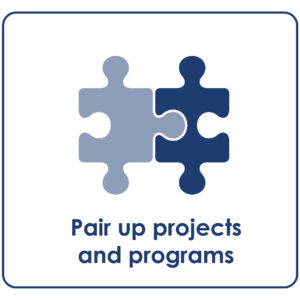 Cycling infrastructure projects and programming can have the greatest impact when they act synergistically in a coordinated policy of strategies to increase cycling. Cycling is sensitive to context, and programs on their own are not sufficient to overcome the broader barriers of built environment or social context. They can, however, amplify the impact of infrastructure projects. Salt Lake City and Chicago provide a telling example: although both cities invested in cycling infrastructure between 1990 and 2000, Chicago also invested in programming to promote commuting by bike, while Salt Lake City did not. Cycling rates in Chicago doubled (from 0.28% to 0.50%), but went nearly unchanged in Salt Lake City (1.52% to 1.49%).
Cycling infrastructure projects and programming can have the greatest impact when they act synergistically in a coordinated policy of strategies to increase cycling. Cycling is sensitive to context, and programs on their own are not sufficient to overcome the broader barriers of built environment or social context. They can, however, amplify the impact of infrastructure projects. Salt Lake City and Chicago provide a telling example: although both cities invested in cycling infrastructure between 1990 and 2000, Chicago also invested in programming to promote commuting by bike, while Salt Lake City did not. Cycling rates in Chicago doubled (from 0.28% to 0.50%), but went nearly unchanged in Salt Lake City (1.52% to 1.49%).
ACTIONS
- Dedicate a portion of your cycling funding to encouragement and education, particularly in areas targeted for new cycling infrastructure.
- Amplify the impact of new cycling infrastructure through other cycling-friendly policies, such as traffic calming on local residential streets and bike parking requirements.
- Pair the opening of new cycling facilities (cycle tracks, off-road path, bike share, etc.) with a community-based campaign to encourage cycling in that neighbourhood. Activities could include themed rides with local elected officials, school-based cycling events, a bike loan program, and incentives for cycling to work.
EXAMPLES
- The City of Vancouver has developed an Active Transportation Promotion and Enabling Plan, with the goal of using cycling promotion efforts most effectively and leveraging existing cycling infrastructure.
- Barcelona’s cycling rates more than doubled in only two years (from 0.75% in 2005 to 1.76% in 2007), thanks to a coordinated package of infrastructure projects and programs. The bike lane network grew from less than 10 km in 1990 to 155 km in 2008, and four traffic-calmed zones with 30km/hr speed limits were introduced. A public bicycle sharing program was started in 2005, and bike parking was increased across the city. Extensive marketing campaigns took place in schools and a city-wide bike week was launched.






